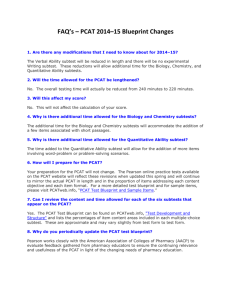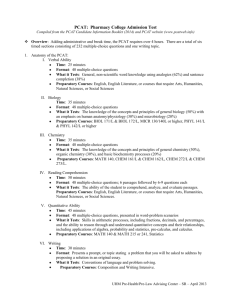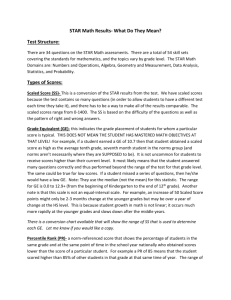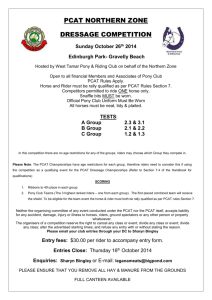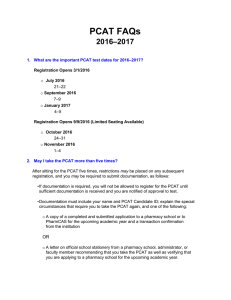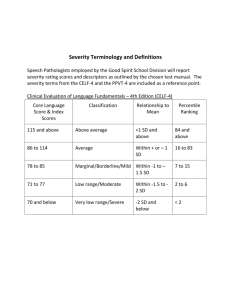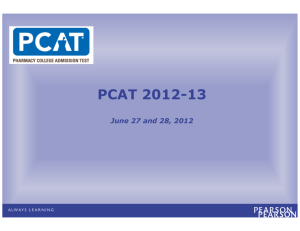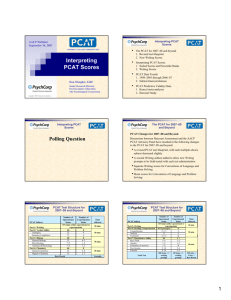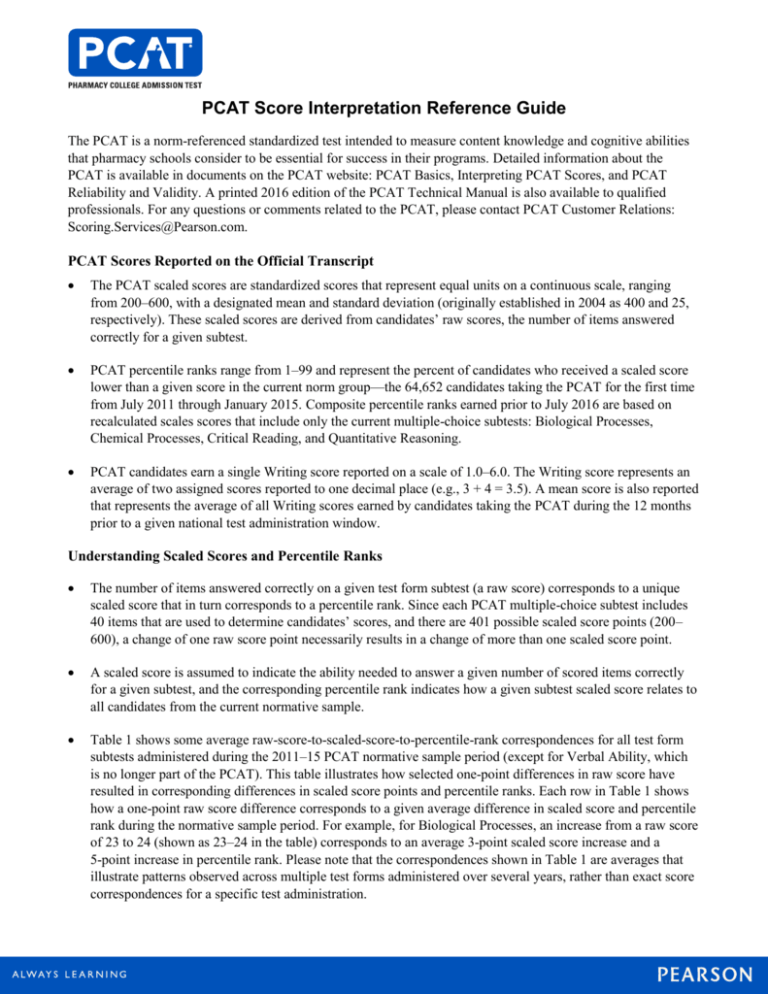
PCAT Score Interpretation Reference Guide
The PCAT is a norm-referenced standardized test intended to measure content knowledge and cognitive abilities
that pharmacy schools consider to be essential for success in their programs. Detailed information about the
PCAT is available in documents on the PCAT website: PCAT Basics, Interpreting PCAT Scores, and PCAT
Reliability and Validity. A printed 2016 edition of the PCAT Technical Manual is also available to qualified
professionals. For any questions or comments related to the PCAT, please contact PCAT Customer Relations:
Scoring.Services@Pearson.com.
PCAT Scores Reported on the Official Transcript
The PCAT scaled scores are standardized scores that represent equal units on a continuous scale, ranging
from 200–600, with a designated mean and standard deviation (originally established in 2004 as 400 and 25,
respectively). These scaled scores are derived from candidates’ raw scores, the number of items answered
correctly for a given subtest.
PCAT percentile ranks range from 1–99 and represent the percent of candidates who received a scaled score
lower than a given score in the current norm group—the 64,652 candidates taking the PCAT for the first time
from July 2011 through January 2015. Composite percentile ranks earned prior to July 2016 are based on
recalculated scales scores that include only the current multiple-choice subtests: Biological Processes,
Chemical Processes, Critical Reading, and Quantitative Reasoning.
PCAT candidates earn a single Writing score reported on a scale of 1.0–6.0. The Writing score represents an
average of two assigned scores reported to one decimal place (e.g., 3 + 4 = 3.5). A mean score is also reported
that represents the average of all Writing scores earned by candidates taking the PCAT during the 12 months
prior to a given national test administration window.
Understanding Scaled Scores and Percentile Ranks
The number of items answered correctly on a given test form subtest (a raw score) corresponds to a unique
scaled score that in turn corresponds to a percentile rank. Since each PCAT multiple-choice subtest includes
40 items that are used to determine candidates’ scores, and there are 401 possible scaled score points (200–
600), a change of one raw score point necessarily results in a change of more than one scaled score point.
A scaled score is assumed to indicate the ability needed to answer a given number of scored items correctly
for a given subtest, and the corresponding percentile rank indicates how a given subtest scaled score relates to
all candidates from the current normative sample.
Table 1 shows some average raw-score-to-scaled-score-to-percentile-rank correspondences for all test form
subtests administered during the 2011–15 PCAT normative sample period (except for Verbal Ability, which
is no longer part of the PCAT). This table illustrates how selected one-point differences in raw score have
resulted in corresponding differences in scaled score points and percentile ranks. Each row in Table 1 shows
how a one-point raw score difference corresponds to a given average difference in scaled score and percentile
rank during the normative sample period. For example, for Biological Processes, an increase from a raw score
of 23 to 24 (shown as 23–24 in the table) corresponds to an average 3-point scaled score increase and a
5-point increase in percentile rank. Please note that the correspondences shown in Table 1 are averages that
illustrate patterns observed across multiple test forms administered over several years, rather than exact score
correspondences for a specific test administration.
Table 1
Average PCAT Subtest Scaled Score (SS) and Percentile Rank (PR) Point Increases for Selected Raw Score (RS)
Increases for the 2011–15 PCAT Normative Sample (lower RS 1–22 not shown)
RS Increase
23–24
24–25
25–26
26–27
27–28
28–29
29–30
30–31
31–32
32–33
33–34
34–35
35–36
36–37
37–38
38–39
39–40
Biological Processes
SS Point
PR Point
Increase
Increase
3
5
3
6
3
5
3
6
3
6
3
6
4
5
3
5
4
5
5
5
5
3
5
3
7
2
8
2
11
0
18
0
18
0
Chemical Processes
SS Point
PR Point
Increase
Increase
3
5
4
7
3
4
3
4
4
5
4
4
4
3
4
3
4
2
5
2
6
2
6
1
8
1
9
0
12
0
21
0
21
0
Critical Reading
SS Point
PR Point
Increase
Increase
3
5
4
8
3
6
4
7
4
8
3
5
4
6
5
7
4
4
5
4
6
3
6
1
8
1
9
0
13
0
21
0
21
0
Quantitative Reasoning
SS Point
PR Point
Increase
Increase
2
4
3
5
4
6
3
4
3
3
3
3
4
3
4
2
4
2
5
2
5
1
6
1
6
0
9
0
11
0
19
0
19
0
Table 1 shows that for test forms administered during the normative sample period, one-point raw score
increases near the upper end (33–34 to 39–40) results in greater scaled score increases than in the 23–24 to
32–33 range, where corresponding scaled scores differences are less.
Table 1 also shows that for
Biological Processes RS
point increases in the 23–24
to 32–33 range, SS
increases result in greater
increases in PR than for
higher RS points, where the
opposite is seen. The reason
for this is that the large size
of the normative sample
used to determine the PRs
resulted in the data forming
a classically shaped bell
curve characteristic of a
normal distribution, as
shown in Figure 1 for the
PCAT Composite scores.
Figure 1
Distribution of Candidates Earning Composite Scaled Score Points
for the 2011–15 Normative Sample
Copyright © 2016 NCS Pearson, Inc. All rights reserved.
For inquiries or reordering, call: 800.622.3231 or go to www.PCATweb.info
12345ABC
Product Number 65697PCAT

